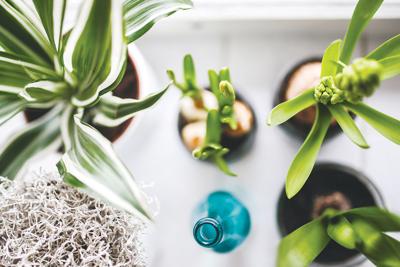Studies have shown that plants in homes and workplaces help reduce stress, increase productivity, enhance employee attitudes, lower operating costs, help in “green building” design, and improve air quality. Although many of these studies involved workplaces, the principles apply to homes as well.
A Human Spaces report in 2015 on biophilic — the innate human connection to nature — design showed that, globally, nearly two-thirds of workers have no plants in their workspaces. Spaces that incorporated plants and other natural elements reported 15 percent higher well-being and creativity, and 6 percent greater productivity.
A 2014 study by the University of Exeter supports this, showing that just a few plants introduced into a work environment can increase productivity 15 percent. Studies in Texas, Washington State, and England showed that employees in environments with plants were 12 percent more productive than those not exposed to interior plants. Visual exposure to plants helped to reduce blood pressure, and recovery from stress within five minutes. A 2010 study by the University of Technology in Sydney quantified several reductions in workplace stress, just from plants. They found reductions of 37 percent in anxiety, 58 percent in depression, 44 percent in hostility, and 38 percent in fatigue. Since green is a calming color, this too should have some effect.
Perhaps some of the increased productivity with plants arises from the reduction in office noise, another factor well-documented in studies. For instance, a small indoor plant hedge around a workspace can reduce noise by five decibels. Plants absorb sound, rather than just insulate against it. A 1995 study from London South Bank University showed a positive effect on noise reduction from large plants placed along wall edges and in corners.
Plants cool by the process of “transpiration”, releasing moisture into the air. A USDA estimate is that proper use of plants could decrease air temperature in an office by as much as 10 degrees. Plus, the moisture released by these plants helps maintain indoor humidity in the human comfort zone of 30 to 60 percent, and helps prevent materials such as wood from cracking when dried out.
Similar to outdoor plants, indoor plants improve the perceived value of spaces, in addition to enhanced aesthetics. A study in England reinforces that indoor plants have a positive effect on perception, while costing less than most other choices for corporate décor. Clients and employees perceive interior spaces with plants as more welcoming, relaxed and upscale.
An often-cited example of the positive effect of plants on perception and value is the study of the Opryland hotel in Nashville. Its occupancy rate is considerably higher than the national average. A scientific case study found that the main factor accounting for this high occupancy is the significant investment (over $1 million) in interior plants, in fact one of the largest investments in indoor plants in the country. This hotel was planted with 12 acres of indoor space, containing about 18,000 indoor plants representing over 600 species.
A pioneering study during the 1980’s was perhaps the first to show that interior plants can have a positive impact on “sick building syndrome.” This is the condition found in many tight, energy-efficient buildings from indoor pollutants. These are the toxic chemicals from building components such as carpets, paints and synthetic construction materials. Such tight buildings can be 10 times more polluted than air outside or in “leaky” environments.
Rooms filled with plants were shown to have 50 to 60 percent fewer molds and bacteria in the air than in rooms where no plants were present. These, and toxins, both are absorbed in the soil, and into plant leaves. Toxins may be translocated down into the root and used there as plant food, or destroyed through a process called “metabolic breakdown”.
For office workers, just having a plant on the desk can improve the 6 to 8 cubic feet of “personal breathing zone” where most the day is spent. Jay Naar, author of “Design for a Livable Planet”, suggests that just 15 to 20 plants can clean the air in a 1,500 square foot area. A good minimum would be two large (10- to 12-inch pots) plants per 100 square feet of space.
Whether you have a workplace, or just home, consider adding some indoor plants if you don’t have them already. Main considerations in choosing plants are their light, humidity and water needs. Most people prefer plants that are low maintenance with few, if any, pests and problems.
Some good choices for bright, indirect light are spider plant, dracaena, and begonia. For lower light, consider peace lily, pothos, Chinese evergreen, or snake plant.
If you have pets, make sure to check the ASPCA website (aspca.org/pet-care), or with your vet, to make sure your plants are not toxic to them. If you have children, check with your doctor or local poison center (poisonhelp.hrsa.gov) on the safety of particular plants.
Dr. Leonard Perry is a horticulture Professor Emeritus at the University of Vermont.














(0) comments
Welcome to the discussion.
Log In
Keep it clean. Please avoid obscene, vulgar, lewd, racist or sexual language.
PLEASE TURN OFF YOUR CAPS LOCK.
Don't threaten. Threats of harming another person will not be tolerated.
Be truthful. Don't knowingly lie about anyone or anything.
Be nice. No racism, sexism or any sort of -ism that is degrading to another person.
Be proactive. Use the "Report" link on each comment to let us know of abusive posts.
Share with us. We'd love to hear eyewitness accounts, the history behind an article.